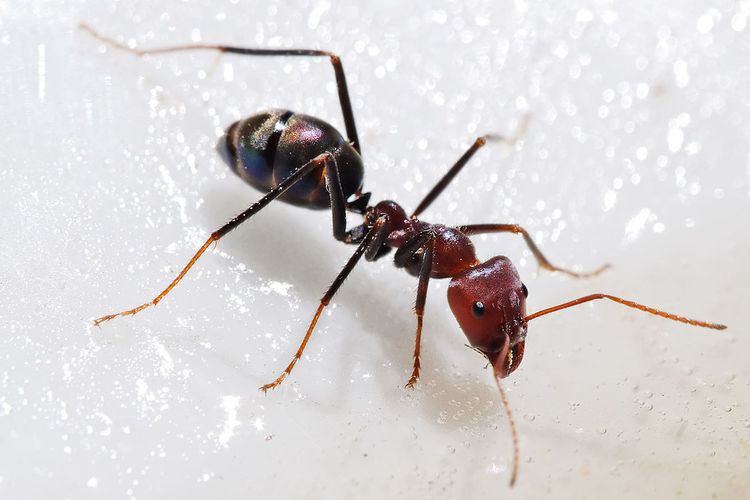Myrmecology (/mɜːrmᵻˈkɒlədʒi/; from Greek: μύρμηξ, myrmex, "ant" and λόγος, logos, "study") is a branch of entomology focusing on the scientific study of ants. Some early myrmecologists considered ant society as the ideal form of society and sought to find solutions to human problems by studying them. Ants continue to be a model of choice for the study of questions on the evolution of social systems because of their complex and varied forms of eusociality. Their diversity and prominence in ecosystems also has made them important components in the study of biodiversity and conservation. Recently, ant colonies are also studied and modeled for their relevance in machine learning, complex interactive networks, stochasticity of encounter and interaction networks, parallel computing, and other computing fields.
The word myrmecology was coined by William Morton Wheeler (1865–1937), although human interest in the life of ants goes back further, with numerous ancient folk references. The earliest scientific thinking based on observation of ant life was that of Auguste Forel (1848–1931), a Swiss psychologist who initially was interested in ideas of instinct, learning, and society. In 1874 he wrote a book on the ants of Switzerland, Les fourmis de la Suisse, and he named his home La Fourmilière (the ant colony). Forel's early studies included attempts to mix species of ants in a colony. He noted polydomy and monodomy in ants and compared them with the structure of nations.
Wheeler looked at ants in a new light, in terms of their social organization, and in 1910 he delivered a lecture at Woods Hole on the “The Ant-Colony as an Organism,” which pioneered the idea of superorganisms. Wheeler considered trophallaxis or the sharing of food within the colony as the core of ant society. This was studied using a dye in the food and observing how it spread in the colony.
Some, such as Horace Donisthorpe, worked on the systematics of ants. This tradition continued in many parts of the world until advances in other aspects of biology were made. The advent of genetics, ideas in ethology and its evolution led to new thought. This line of enquiry was pioneered by E. O. Wilson, who founded the field termed as sociobiology.
Ants often are studied by engineers for biomimicry and by network engineers for more efficient networking. It is not known clearly how ants manage to avoid congestions and how they optimize their movements to move in most efficient ways without a central authority that would send out orders. There already have been many applications in structure design and networking that have been developed from studying ants, but the efficiency of human-created systems is still not close to the efficiency of ant colonies.
Note: Names are listed alphabetically.
Ernest André (1838–1911), French entomologistThomas Borgmeier (1892–1975), German-Brazilian theologian and entomologistWilliam L. Brown, Jr. (1922–1997), American entomologistGiovanni Cobelli (1849–1937), Italian entomologist, director of the Rovereto museumArthur Charles Cole, Jr. (1908–1955), American entomologistWalter Cecil Crawley, British entomologistWilliam Steel Creighton (1902–1973)Horace Donisthorpe (1870–1951), British myrmecologist, named several new speciesCarlo Emery (1848–1925), Italian entomologistJohan Christian Fabricius (1745–1808), Danish entomologist, student of LinnaeusAuguste-Henri Forel (1848–1931), Swiss myrmecologist, studied brain structure of humans and antsÉmil August Goeldi (1859–1917), Swiss-Brazilian naturalist and zoologistWilliam Gould (1715–1799), described by Horace Donisthorpe as "the father of British myrmecology"Robert Edmond Gregg (1912–1991), American entomologistThomas Caverhill Jerdon (1811–1872), British physician, zoologist and botanistWalter Wolfgang Kempf (1920–1976), Brazilian myrmecologistHeinrich Kutter (1896–1990), Swiss myrmecologistNicolas Kusnezov also as Nikolaj Nikolajevich Kuznetsov-Ugamsky (1898–1963)Pierre André Latreille (1762–1833) French entomologistSir John Lubbock (the 1st Lord and Baron Avebury) (1834–1913), wrote on hymenoptera sense organsWilliam T. Mann (1886–1960), American entomologistGustav Mayr (1830–1908), Austrian entomologist and professor in Pest and Vienna, specialised in HymenopteraCarlo Menozzi also as Carlo Minozzi (1892–1943), Italian entomologistWilhelm Nylander (1822–1899), Finnish botanist, briologist, micologist, entomologist and myrmecologistBasil Derek Wragge-Morley (1920–1969), research included genetics, social behaviour of animals, and the behaviour of agricultural pestsFergus O'Rourke (1923– 2010), Irish zoologistJulius Roger (1819–1865), German physician, entomologist and folkloristFelix Santschi (1872–1940), Swiss entomologistTheodore Christian Schneirla (1902–1968), American animal psychologistFrederick Smith (1805–1879), worked in the zoology department of the British Museum from 1849, specialising in the HymenopteraRoy R. Snelling (1934–2008), American entomologist credited with many important finds of rare or new ant speciesErich Wasmann (1859–1931), Austrian entomologistNeal Albert Weber (1908–2001), American myrmecologistJohn Obadiah Westwood (1805–1893), English entomologist and archaeologist also noted for his artistic talentsWilliam Morton Wheeler (1865–1937), curator of invertebrate zoology in the American Museum of Natural History, described many new speciesDonat Agosti, Swiss entomologistCesare Baroni Urbani, Swiss ant taxonomistMurray S. Blum (1929–), American chemical ecologist, an expert on pheromonesBarry Bolton, English ant taxonomistAlfred Buschinger, German myrmecologistHenri Cagniant, French myrmecologistJohn S. Clark, Scottish myrmecologistCedric Alex Collingwood, British entomologistMark Amidon Deyrup, American myrmecologistFrancesc Xavier Espadaler i Gelabert, Spanish (Catalan) myrmecologist, specialist in Mediterranean and Macaronesian ants and in invasive speciesDeborah Gordon (1955–), studies ant colony behavior and ecologyWilliam H. Gotwald, Jr., American entomologistMichael J. Greene studies interactions between chemical cues and behavior patternsBert Hölldobler (1936–), Pulitzer Prize winning German myrmecologistLaurent Keller (1961–), Swiss evolutionary biologist and myrmecologistJohn E. LattkeJohn T. Longino, American entomologistMark W. Moffett (1958–), American entomologist and photographerCorrie S. Moreau, American evolutionary biologist and entomologist, wrote on evolution and diversification of antsJustin Orvel Schmidt, American entomologist, studies the chemical and behavioral defenses of ants, wasps, and arachnidsBernhard Seifert, German entomologistSteven O. Shattuck, American-Australian entomologistMarion R. Smith, American entomologistRobert W. Taylor, Australian myrmecologistAlberto Tinaut Ranera, Spanish myrmecologistWalter R. Tschinkel, American myrmecologistJames C. Trager, American myrmecologistGary J. Umphrey, American biostatistician and myrmecologistPhilip S. Ward, American entomologistEdward Osborne Wilson (1929–), Pulitzer Prize winning American myrmecologist, revolutionized the field of sociobiologyMyrmecochorous (adj.) dispersed by antsMyrmecophagous (adj.) feeding on antsMyrmecophile (n.) an organism that habitually shares an ant nest, myrmecophilous (adj.), myrmecophily (n.)Myrmidons (n.) ant-men in Metamorphoses and in Homer's Iliad, where they are Achilles' warriors
